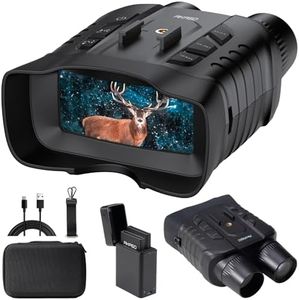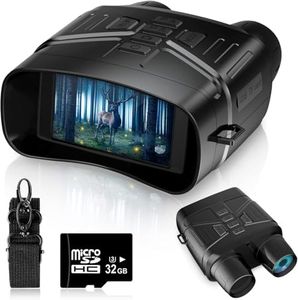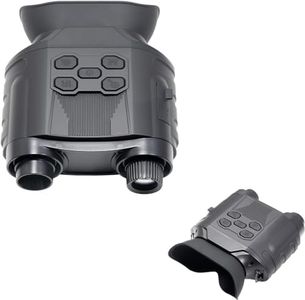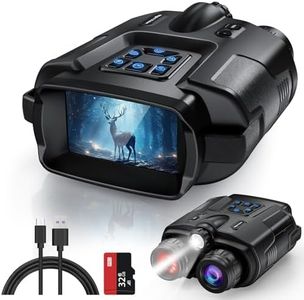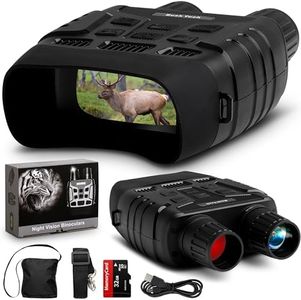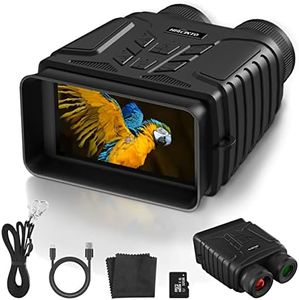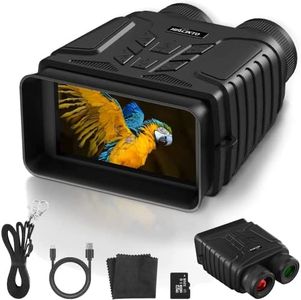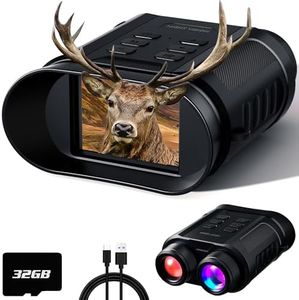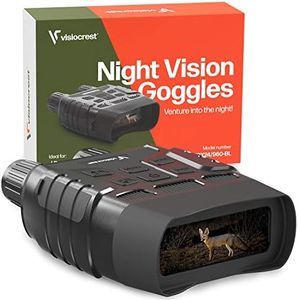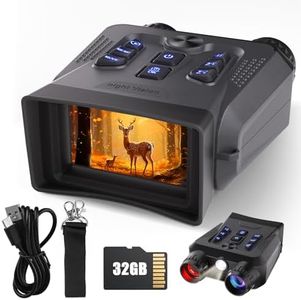We Use CookiesWe use cookies to enhance the security, performance,
functionality and for analytical and promotional activities. By continuing to browse this site you
are agreeing to our privacy policy
10 Best Night Vision Binoculars
From leading brands and best sellers available on the web.Buying Guide for the Best Night Vision Binoculars
Choosing the right night vision binoculars can make a big difference in how much you enjoy and benefit from nighttime viewing. Whether you’re interested in wildlife observation, nighttime navigation, security, or just exploring the outdoors after dark, understanding the features and technical specifications will help you make a smart choice. It’s important to consider how and where you’ll be using your binoculars, as your needs will guide you toward the features that matter most. Let’s go through the key specs and what you need to know about each to find the perfect pair for you.MagnificationMagnification refers to how much larger objects appear when you look through the binoculars. Common magnifications for night vision binoculars range from 2x to 8x. Lower magnification, like 2x or 3x, gives you a wider field of view and is easier to keep steady, making it great for moving targets or scanning large areas. Higher magnifications, like 7x or 8x, let you see farther but can make the image shakier and narrower. To pick the right magnification, think about whether you’ll be observing close-up details or scanning broader landscapes. For general use or walking and spotting animals, lower magnification is easier to handle. If you need detailed viewing from a distance and don’t mind a smaller viewing area, go higher.
GenerationNight vision devices come in different 'generations,' which refer to the type and quality of image intensifier technology used. Generation 1 is the most basic, providing usable images but with limited range and more visible noise. Generation 2 offers a clearer, brighter image and works better in very low light. Generation 3 and above provide excellent clarity, greater detail, and longer viewing distances even in nearly total darkness, but are mainly for professional or very serious use. If you’re a casual user, Generation 1 is usually enough. For more demanding activities or frequent use, you might prefer Generation 2. Think about how sharp and bright you need the image to be, and whether you expect to use the binoculars in very dark places.
Objective Lens DiameterThe objective lens diameter is the size of the front lenses, usually measured in millimeters. A larger lens lets in more light, which is especially important at night for creating a brighter image. Values typically range from 20mm to 50mm. Smaller lenses make the binoculars lighter and more compact but may not perform as well in very low light. Larger lenses are better for seeing in darker conditions but can be heavier to carry. If you prioritize portability and will be in moderately lit environments, go for a smaller lens. For maximum brightness and better detail in very low light, choose a larger diameter.
Infrared (IR) IlluminatorAn IR illuminator is built into many night vision binoculars and acts like an invisible flashlight to help see in total darkness. Its power and range vary between models. A longer-range, adjustable IR is best for spotting things far away, while basic IR is fine for close or indoor use. If you expect to be in places with zero light, or want extra visibility, prioritize models with a strong IR illuminator. For more casual use where some ambient light is available, a standard IR will suffice.
Viewing RangeViewing range tells you how far you can see clearly in the dark with your binoculars. Typical ranges can be anywhere from around 100 up to over 1000 meters depending on the technology and environment. Short range is enough for backyard or campsite use, while a longer range benefits activities like surveillance or hunting. Match the range to your intended use: if you only need to see nearby objects, don’t worry about maximum distance. If you want to spot wildlife or objects far away, look for a longer viewing range.
ResolutionResolution describes how much detail you can see—higher resolution means a sharper and clearer image. It is usually measured in lines per millimeter (lp/mm). Entry-level units may have lower resolution, making images fuzzier, while better models offer more detail. Consider how important image clarity is for your activity. If you need to identify animals or objects at a glance, aim for higher resolution. If general navigation is your goal, standard resolution should be sufficient.
Weight and SizeThe weight and size of night vision binoculars affect how easy they are to carry and use, especially for long periods. Compact and lightweight options are best for hiking or travel, while larger models may offer better optics but can get tiring to hold. Think about whether you’ll need to pack light or if you can handle a heavier device. Your comfort and how long you’ll use the binoculars at once should guide your choice.
Battery LifeNight vision binoculars run on batteries, and different models last longer than others. Battery life is usually given in hours of use. Shorter battery life limits the time you can spend outdoors before changing batteries, while a longer life lets you use them for extended trips. Consider how often and how long you plan to use the binoculars, and if you’ll have access to extra batteries or recharging options.
